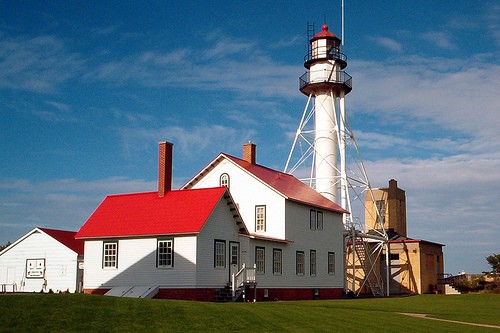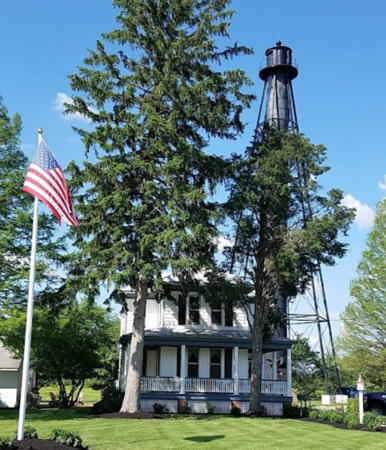Onshore Skeletal Lighthouses, 1861-1910
Skeletal frame light towers are common as aids to navigation, and the smaller ones
are usually not considered to be lighthouses. However, during
the late nineteenth century and the first years of the twentieth,
larger skeletal towers were installed at several dozen light stations
throughout the country. These lights were tended by keepers (at
least originally), and they were and are listed as lighthouses.
The identifying characteristic of these skeletal lighthouses is the central
cylinder, a broad tube up the middle of the tower that enclosed
the stairway and protected the keeper as he climbed to the lantern
room. All the skeletal lighthouses had enclosed lantern rooms,
and most had enclosed watch rooms below the lantern.
In the U.S., skeletal lighthouses became very popular with Congress because they
cost less than half the price of a stone or brick tower of the
same height. Since they were assembled from prefabricated sections,
they could be built quickly, even at remote locations. If necessary,
they could also be disassembled and shipped to a new location.
|
"Whitefish Point Class" Michigan Experimentals (1861)
The first onshore skeletal lighthouses in the U.S. were three experimental
towers built in Michigan in 1861. Two were built on Lake Superior, one
at Whitefish Point and the other at Manitou Island off the Keweenaw Peninsula.
These are short lighthouses, about 75 feet (23 m) tall, connected to their keeper's
quarters by an enclosed passageway. The towers have a square footprint,
but the watch and lantern rooms are octagonal. The lowest section of the
tower is vertical rather than pyramidal; this differs from all the subsequent
designs. The central cylinder is 6 ft (1.8 m) in diameter, but it does reach the ground; instead, it is connected to the keeper's house by a enclosed walkway at the second-floor level. The Manitou Island lighthouse is identical in design.
The experiment was evidently successful, as both of these lighthouses
have remained in use to the present day. The Whitefish Point Light is
beautifully preserved by the Great
Lakes Shipwreck Museum. The Manitou
Island Light, however, is increasingly endangered by beach erosion.
The third lighthouse of this class was the DeTour
Point Light, built on Lake Huron at the mouth of the St.
Mary's River. It was demolished in 1931 when the DeTour Reef
Light was built offshore to replace it.
|
 Whitefish Point Light, Michigan, September 2005
Whitefish Point Light, Michigan, September 2005
Flickr Creative Commons photo by Heidi Blanton
|
 Liston Range Rear Light,
Port Penn, JMay 2018
Liston Range Rear Light,
Port Penn, JMay 2018
Google Maps photo by Ken Nichols |
"Liston Class" Delaware Bay Hexagonals (1876-1881)
In 1876 the Lighthouse Board needed to build half a dozen
tall lighthouses as the rear lights of ranges along the Delaware
Bay and River. To meet this need the Board built skeletal towers
with a hexagonal footprint. These "Liston class" lighthouses
have very sturdy legs and light cross-bracing. The central cylinder
is large and the round lantern and watch rooms are small (the
three 1876-77 towers lack watch rooms completely), giving the
towers a "small head on a big body" appearance. The
towers range in height from 85 to 120 feet. Five of the six towers
survive but three have been relocated.
- Deepwater
Range Rear, New Jersey (1876); this lighthouse was demolished in 1956.
- Port Penn Range Rear, Delaware (1877); this lighthouse was relocated to Liston
Range Rear, Delaware in 1906.
Lacking a watch room, this lighthouse exemplifies the "small head on a big body" profile. At 120 ft (36.5 m) it is also the tallest of the group.
The lighthouse is now in private ownership.
- Finns Point Range
Rear, New Jersey (1877). This lighthouse has the same design as the Port Penn/Liston lighthouse. Both lighthouses were prefabricated by the Kellogg Bridge Company in Buffalo, New York.
The lighthouse is owned by the U.S. Fish and Wildlife Service.
- Schooner Ledge Range Rear, Pennsylvania (1880), relocated to
Michigan Island, Wisconsin in 1929. This lighthouse was disassembled and in storage from 1919 to 1929. The 1880 design included a round watch room, and the towers are somewhat more broadly pyramidal.
This lighthouse is owned by the National Park Service as part of the Apostle Islands National Lakeshore.
- Tinicum
Island Range Rear, New Jersey (1880). For many years this was the only one of the lighthouses in this group open for climbing.
The lighthouse is owned by the Coast Guard but leased to the Borough of Paulsboro.
- Delaware Breakwater Range Rear, Delaware (1881), relocated
to Boca
Grande Entrance Range Rear, Florida in 1932. This lighthouse lacks a watch room and is more like the 1877 design than the 1880 design.
The lighthouse was prefabricated in Trenton, New Jersey, by the Phoenix Iron Company.
It is now leased to the Barrier Islands Parks Society and is open twice a month for climbing.
There is a seventh hexagonal skeletal lighthouse, the Hilton Head Range
Rear Light in South Carolina (1880). Unique in design, it differs
from the Delaware Bay lights in having lighter-weight legs and a hexagonal
rather than round lantern room. |
|
"Sanibel Class" Square Skeletals (1884-1910)
Beginning in 1884, the Lighthouse Board adopted a standard
plan for skeletal lighthouses having a square footprint. This
plan was used for lighthouses with heights up to about 100 feet.
The lighthouses have octagonal watch and lantern rooms, each
with a gallery. In taller towers, a distinctive feature of the
design is an extra leg running about half way up the side of
each face. Shorter towers (65-75 feet) have only three sections
and lack these extra legs.
At least 17 of these lighthouses were built, and 13 of them survive.
- Sanibel
Island, Florida (1884), 102 ft (31 m).
- Cape
San Blas, Florida (1885), 90 ft (27.5 m).
This lighthouse has been relocated to Port St. Joe.
- Anclote
Key, Florida (1887), 105 ft (32.5 m).
The first three Florida lighthouses have identical designs.
- Coney
Island, New York (1890), 70 ft (21 m). The first of the shorter-design
towers.
- Throgs Neck, New York (1890), 70 ft (21 m). Identical to the Coney Island lighthouse, this tower was short-lived; it was removed in 1906 because the Army judged it to be an obstruction to artillery at Fort Schuyler.
- Point
Loma, California (1891), 70 ft (21 m). The only West Coast example of the class, this lighthouse was prefabricated (presumably like the Coney Island and Throgs Neck lighthouses) by the Phoenix Iron Company at Trenton, New Jersey, and shipped across the country.
- Waackaack Range Rear, New Jersey (1894), 106 ft (31 m). To the dismay of lighthouse fans, this lighthouse was demolished in the late 1950s.
- Crooked
River (Carrabelle), Florida (1895), 103 ft (31.5 m). This lighthouse appears identical to the earlier Florida towers.
- Chandeleur, Louisiana (1896), 103 ft (31.5 m). Abandoned in 2001, this lighthouse was destroyed by Hurricane Katrina in 2005.
- Marblehead, Massachusetts (1896), 105 ft (32 m). This is the only representative of the class in New England.
- Brazos River, Texas (1896), 96 ft (29 m). This lighthouse was deactivated and demolished in 1967.
- LaPointe, Wisconsin (1896), 65 ft (19.5 m). This is the first of three shorter-design towers built on the Great Lakes. They are practically identical to the Coney Island Light.
- Plum
Island Range Rear, Wisconsin (1897), 65 ft (19.5 m).
- Duluth
Harbor South Breakwater Inner, Minnesota (1901, 67 ft (20 m).
- Sapelo
Island, Georgia (1905), relocated to South
Fox Island, Michigan in 1934, 100 ft (30.5 m).
- Bellevue
Range Rear, Delaware (1909), 105 ft (31 m).
The last stand of the Sanibel class lighthouses was on Delaware Bay. This lighthouse was deactivated in 2000 and is now endangered.
- Reedy
Island Range Rear, Delaware (1910), 110 ft (33.5 m). The last lighthouse of the class is also the tallest.
|
 Sanibel Island Light, Sanibel, October 2022
Sanibel Island Light, Sanibel, October 2022
Instagram photo by Sanibel Star |
 Rawley Point Light, Two Rivers, September 2020
Rawley Point Light, Two Rivers, September 2020
Instagram photo by PhotographybyBrianna |
"Rawley Point Class" Tall Octagonals (1894-1907)
Around 1900, it became necessary to build several tall lighthouses. Unfortunately,
Congress was no longer approving expensive new masonry towers, so the
Lighthouse Board developed a robust skeletal design for lighthouses with
an octagonal footprint, sturdy legs, a large lantern room suitable for
a Fresnel lens of the first order, a two-story watch room, and two or
three galleries. Only five of these graceful and imposing lighthouses
were built, and sadly only three survive:
- Rawley
Point (Twin Rivers Point), Wisconsin (1894), 111 ft (34 m).
This is the tallest lighthouse on the Great Lakes (U.S. or Canada). It was built using parts of the 1859 Chicago North Pier lighthouse, which had a shorter and simpler octagonal design.
- Cape
Charles, Virginia (1895), 191 ft (58 m). This is
actually the second-tallest U.S.
lighthouse, only a few feet shorter than the famous brick tower
at Cape Hatteras.
- Hog Island, Virginia (1896), 191 ft (58 m). This twin of the Cape Charles Light was threatened by beach erosion and demolished in 1948.
- Cape Fear, North Carolina (1903), 150 ft (48 m). This lighthouse was demolished in 1958, a terrible and unnecessary loss.
- Hillsboro
Inlet, Florida (1907), 137 ft (42 m).
|
Saving the Skeletals
With regular maintenance, the skeletal lighthouses hold up well over time.
Most of them are still in service and remain in pretty good shape. In 2000 the
Coast Guard carried out a thorough restoration
of the Cape Charles Light, a project that illustrates the challenges involved
in conservation of these iron towers. A number of structural elements of the
tower had corroded to the point of failure, but because the tower is over-engineered
other elements were holding it up nicely. The corroded parts had to be replaced
with modern structural steel, which should suffice for many years. Carrying
out the work was a problem, though. Like many of the skeletal towers, the lighthouse
is in a remote and difficult location. Pieces of steel weighing up to a ton
and a half had to be landed on an island with no dock, carried through an environmentally
sensitive wetland, and installed in the face of heat, insects, and the threat
of hurricanes.
If skeletal towers are abandoned, they corrode and deteriorate rapidly. This
was the situation at Anclote Key, Florida, which was for a time the only onshore skeletal
lighthouse on the Lighthouse Digest Doomsday
List. Fortunately, a local support group and Florida State Parks worked
together to save the light station and in 2003 the International Chimney Corporation
carried out a complete restoration. The lighthouse at Cape San Blas, Florida, was gravely endangered by beach erosion; it did time on the Doomsday List before it was saved by relocation to Port St. Joe. There is great concern for the abandoned Bellevue Range Rear Lighthouse in Delaware, and it is now on the Doomsday List.
Long ignored by the public, the pyramidal skeletal lighthouses
are finally receiving the attention they deserve. With care,
these towers can be preserved for future generations of lighthouse
fans.
Return to the Lighthouse Directory
index
Posted Dece,ber 7, 1999. Checked and updated October 19, 2018. Site copyright 2018 Russ
Rowlett and the University of North Carolina at Chapel Hill.



